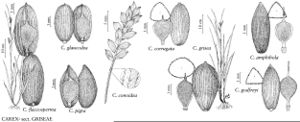Carex amphibola
Syn. Pl. Glumac. 2: 234. 1855.
Plants densely cespitose; rhizo1me internodes 1.2–2 mm thick. Culms dark purple-red to 0.3–2.4 (–7.3) cm high or very rarely brown at base, 15–80 cm. Leaves: sheaths glabrous; blades green, widest blades (3.7–) 4.4–7 mm wide, smooth abaxially. Inflorescences 0.48–0.93 of culm height; peduncles of lateral spikes glabrous or barely scaberulous; peduncles of terminal spikes 1.6–21 (–37) mm, usually barely exceeding lateral spikes; proximal bract sheaths loose, glabrous abaxially, sheath front slightly concave to slightly convex, elongated 0.6–2.2 (–5) mm beyond apex; ligules (1.8–) 3.4–7.8 (–12.9) mm; distal bract much exceeding terminal spike. Spike (3–) 4–5, distal 2–4 overlapping; lateral spikes pistillate, with 3–18 perigynia, 5–26 × 4.6–9.8 mm, ratio of spike length (in mm) to flower number = 1.3–1.9; terminal spikes 7–34 × 1.1–2.7 mm. Pistillate scales 3.7–8 × 1.2–2.4 mm, margins whitish and usually with redbrown speckles, entire, apex with awn 1.1–6 mm. Staminate scales 3.6–4.9 × 1.1–1.9 mm. Anthers 2–2.8 mm. Perigynia spirally imbricate, 52–64-veined, unwrinkled to wrinkled, oblong-lanceoloid to narrowly oblong-ovoid, obtusely triangular in cross-section, 4.2–5 (–5.2) × 1.5–1.9 (–2.2) mm, (2.2–) 2.5–3.1 times as long as wide, lustrous, base very gradually tapered, apex gradually tapered; beak absent or straight, 0–0.2 mm. Achenes broadly obovoid to oblong-obovoid, widest at 0.55–0.67 (–0.7) of body length, (2.6–) 2.8–3.4 × (1.3–) 1.5–1.7 (–1.8) mm, loosely enveloped by perigynia; stipe straight, (0.3–) 0.4–0.6 mm; beak straight, 0.3–0.6 mm.
Phenology: Fruiting spring–early summer.
Habitat: Mesic deciduous forests, usually in acidic loams on flood plains, slopes above streams, and uplands
Elevation: 10–1000 m
Distribution

Ont., Ala., Ark., Conn., Del., D.C., Ga., Ill., Ind., Ky., La., Md., Mass., Mich., Miss., Mo., N.J., N.Y., N.C., Ohio, Okla., Pa., S.C., Tenn., Tex., Va., W.Va.
Discussion
The wide-ranging, habitat generalist Carex amphibola is the most common member of Carex sect. Griseae. It grows with many other members of the section, most often C. bulbostylis, C. corrugata, C. glaucodea, C. grisea, C. oligocarpa, and C. planispicata.
Selected References
None.
Lower Taxa
"shortened" is not a number.
